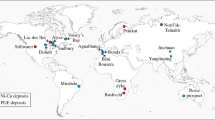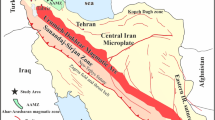Abstract
Complete chemical analyses, including ferric and ferrous iron, H2O contents and δD values for 16 phlogopite and biotite and 2 hornblende separates are presented. Samples were obtained from volcanic rocks from four localities: (1) phlogopite phenocrysts from minette lavas from the western Mexico continental arc, (2) biotite and hornblende phenocrysts from andesite lavas from Mono Basin, California, (3) phlogopite and biotite from clinopyroxenite nodules entrained in potassic lavas from the East African Rift, Uganda, and (4) phlogopite phenocrysts from a wyomingite lava in the Leucite Hills, Wyoming. The Fe2O3 contents in the micas range from 0.8 to 10.5 wt%, corresponding to 0.09 to 1.15 Fe3+ per formula unit (pfu). Water contents vary from 1.6 to 3.0 wt%, corresponding to 1.58 to 3.04 OH pfu, significantly less than would be expected for a site fully occupied by hydroxyl. Cation- and anion-based normalization procedures provide accurate mineral formulae with respect to most cations and anions, but are unable to generate accurate estimates of Fe3+/FeT, and overestimate OH at the expense of O on the hydroxyl site. These inaccuracies are present despite acceptable adjusted totals and stoichiometric calculated site occupancies. The phlogopite and biotite phenocrysts in arc-related lavas from western Mexico and eastern California have the highest Fe3+/FeT ratios (56–87%), reflecting high magmatic oxygen fugacities (ΔNNO = +2 to +5), in contrast to those from Uganda (25–40%) and the Leucite Hills (23%). There is no correlation between the OH content and the Fe3+/FeT ratio in the micas. Values of KMg/Fe2+D (± 2σ errors) were calculated for three phlogopite-olivine pairs (0.12 ± 0.12, 0.26 ± 0.14, 0.09 ± 0.12), two biotite-hornblende pairs (0.73 ± 0.08 and 1.22 ± 0.10) and a single phlogopite-augite pair (1.15 ± 0.12). Values of KF/OHD for two biotite and hornblende pairs could not be determined without significant error because of the extremely low F contents (< 0.2 wt%) of the four phases. The δD values obtained in this study encompass a large range (−137 to −43‰). The phlogopite and biotite separates from Uganda have δD values of −70 to −49‰, which overlap those believed to represent “primary” mantle. There is a larger range in δD values (−137 to −43‰) for phlogopite phenocrysts from western Mexico minette lavas, although their range in δ18O values (5.2–6.2‰) is consistent with “normal” mantle. It is unlikely, therefore, that the variable δD values reflect heterogeneity in the mantle source region of the minette magmas. Nor can the extremely low δD values reflect degassing of H2 or H2O since almost 100% loss of dissolved water in the magma is required, an unrealistic scenario given the stability of the hydrous phenocrysts. The very low δD values of the Mascota minette phlogopites require that the hydrogen be introduced from an external source (e.g., meteoric water). Whatever the process responsible for the observed hydrogen isotope composition, it had no effect on the δ18O value, f O 2, a H 2O or bulk composition of the host magmas.
Similar content being viewed by others
Author information
Authors and Affiliations
Additional information
Received: 5 January 1995 / Accepted: 19 March 1996
Rights and permissions
About this article
Cite this article
Feldstein, S., Lange, R., Vennemann, T. et al. Ferric-ferrous ratios, H2O contents and D/H ratios of phlogopite and biotite from lavas of different tectonic regimes. Contrib Mineral Petrol 126, 51–66 (1996). https://doi.org/10.1007/s004100050235
Issue Date:
DOI: https://doi.org/10.1007/s004100050235




